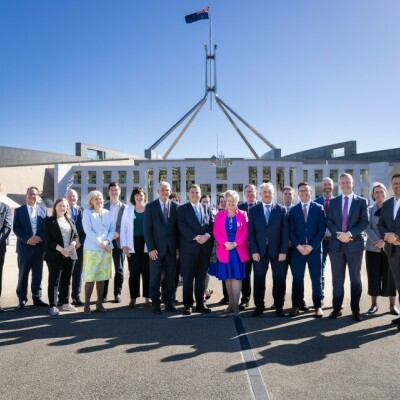Below is a media release issued by the National Growth Areas Alliance (NGAA).

The outer suburbs are growing more than twice as fast as the rest of the nation and doing the heavy lifting for our housing supply, but struggle to get vital infrastructure that other areas take for granted, Mayors and Councillors from Australia's fastest growing council areas told Members of Parliament in Canberra last week.
"Australia's population growth stopped during the pandemic - but not in growth areas. In the past decade, the population of growth areas increased by 34% while Australia's total population grew by just 14.9%. Yet there is no specific funding to get basic infrastructure into these new communities," said Councillor Matthew Deeth, Chair of the National Growth Areas Alliance.
Councillor Deeth said, "The municipalities that our Alliance represents are home to 5.3 million people. One fifth of Australia's population lives in just 29 municipalities. We're building most of Australia's new houses in the places with the least supporting infrastructure."
Deputy Mayor, Matt Deeth said, "We came to Canberra to make sure the new government understands the situation experienced by millions of people living in Australia's outer suburbs. Homes and neighbourhoods are built in designated growth zones as part of local and state government plans. But the building often stops there. Freeway and highway upgrades, bus routes, railway lines, walking and cycle paths should all be built as part of the plan. But they are not, and the result is nightmare commutes and long drives to get to study, health services and sports facilities far from home."
"Growth is a national issue that the Albanese Government must urgently address, and the missing step is national coordination - with all levels of government working together to address the uneven distribution of people, jobs, houses and infrastructure," said Councillor Deeth.
"The NGAA is calling for a comprehensive national approach with all levels of government working together to address the unequal distribution of people, jobs, houses and infrastructure," Councillor Deeth said.
"With another million houses to be built in the five years from 2024, Australia has an opportunity to learn from past mistakes, to build world-leading suburbs and provide the foundation for more than a million children in our areas to reach their full potential."
Key facts about growth areas
- One in every five Australians lives in a growth area - 5.3 million people. Yet there is no specific funding for getting basic infrastructure into these new communities.
- Growth areas are growing at nearly three times the national average (2.9% compared to 1.2%) despite commentary that Australia's population growth stopped during the pandemic.
- The population of growth areas increased by 34% in the past decade while Australia's total population grew by just 14.9% (2011 - 2021)
Size of the sustained housing boom
- More than a thousand new homes approved in growth areas every week for the past six years - that's one thousand families moving in every week without sufficient schools, access roads, health services planned, let alone delivered.
- More than 60,000 new dwelling approvals every year for the past decade. How will these areas cope when the Government's million new houses land?
Vulnerable communities
- Australia's most mortgaged electorates are in growth areas. Households in the outer suburbs suffer the most mortgage stress with young families and new homeowners vulnerable to rate rises. 43% of growth area households have a mortgage (33.2% in the rest of Australia).
Latest growth areas research
State of Australia's Growth Areas: Demographic and Socio-economic Characteristics of Growth Areas report - .id Informed Decisions (2022)
This report presents the demographic and socio-economic characteristics of local government areas that are part of the NGAA, from Census 2021.
See report here: https://bit.ly/NGAAresearch2022






